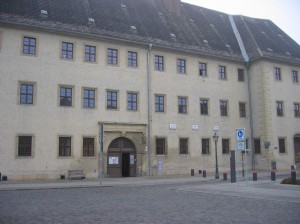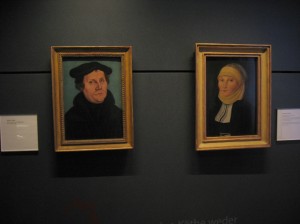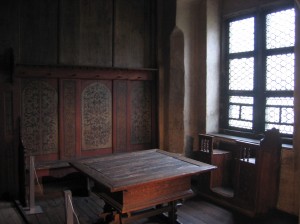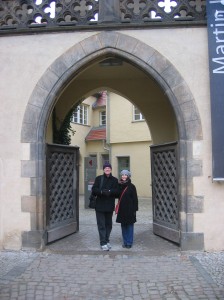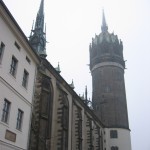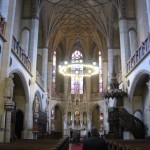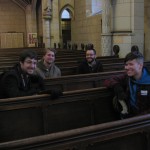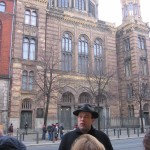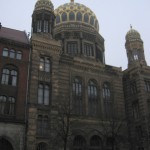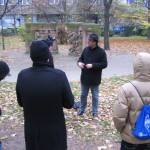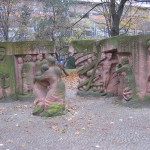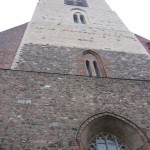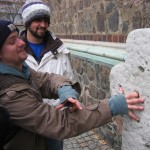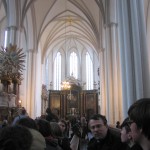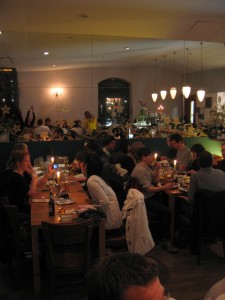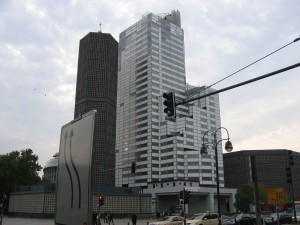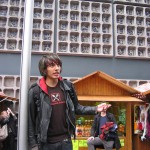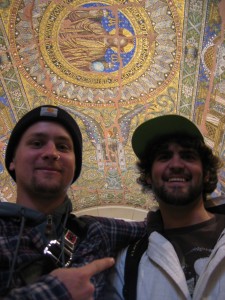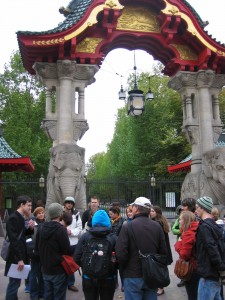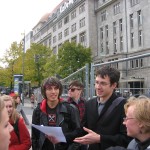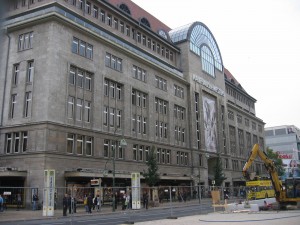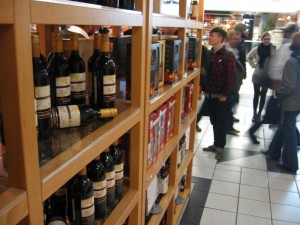A trip to Wittenberg
This Tuesday we took a day trip to the town of Wittenberg, about an hour away by train.
Wittenberg’s most famous resident was, of course, Martin Luther, who lived here in what was an Augustinian monastery and, after the Reformation, a school and his private residence.
The building is now an excellent museum on the history of the Reformation. One of its best features is the many paintings by Lucas Cranach, who was a close friend of Luther’s. Here are Cranach’s portraits of Luther and his wife Katharina, a former nun. Their marriage has become such a legend that it is reenacted every summer by the locals in Wittenberg!
A few of the rooms are wonderfully preserved, as well. Here is one of the rooms that Luther used as an everyday living space.
(John and Eleanor paused for a quick photo under the portal to Luther’s house.)
The other important site in Wittenberg is the Schlosskirche, where Luther famously nailed his 95 theses on the door in 1517. The church has burned down and been rebuilt since then, but it’s still a pretty amazing piece of history!
One thing that has really been brought home to us – especially in these last weeks, as we discuss contemporary German identity – is just how integral Christian, and in the north, especially Protestant, history is to an understanding of what many people believe it means to be German. This is where it all started, after all! And, as the history of the Reformation shows us, changing people’s assumptions can be difficult. As Germany moves into an age where multiculturalism is increasingly a feature of the social landscape, it will be interesting to see how they make sense of the shifts in religious identity, as well.
A tour of Mitte with Ulf Heinsohn
This Tuesday we took a walk through cold, foggy Mitte with Ulf Heinsohn, who helped us unpack some of the layers of meaning in the architecture around us. One of our first stops was the Neue Synagoge, or New Synagogue. Built in the 1860s, the building referred to both the history of Judaism and to its connections with Berlin: the style reflects one of the high points of Jewish culture (the Moorish architecture of the medieval period in Spain, where synagogues took on a look borrowed from Islamic architecture), but it uses a local traditional material (brick).
We also stopped at the Rosenstrasse memorial, which honors the wives of Jewish forced laborers who successfully protested their husbands’ deportation. The memorial was designed by the daughter of one of these couples.
At the Marienkirche, one of the oldest churches in Berlin, we learned how the architecture reflects the changes in the church community. The windowless front of the church was built that way in order to function as a fortress in case of invasion during the late medieval period. The cross in front of the church functioned in “trials by ordeal” — if the accused could fit their fingers in all five holes, they were considered innocent!
Our walk in the cold weather definitely earned us a delicious meal. Our group enjoyed a wonderful dinner together that night at Matzbach, one of our favorite German restaurants!
Ku’damm, Zoo and KaDeWe with Robert, Dan and Niguel
Our students Robert, Dan and Niguel took us on a great tour of the Ku’Damm/Zoostation area of Berlin this Tuesday. We began just off the Ku’Damm at the Gedächtniskirche – the ruin of a church built by Kaiser Wilhelm II and bombed in 1943. The ruin has become one of the symbols of Berlin, but you can’t see it at the moment – it’s under that ugly white scaffolding you can see in the picture above. Surrounding the ruin are a chapel and belltower designed by the German modernist Egon Eiermann in the 1950s.
We headed into the ground floor of the ruin first. The ceiling still displays some beautiful Byzantine-style mosaics, duly appreciated by our class …
We then headed next door to the Eiermann-designed chapel. Though the newer buildings aren’t much to look at from the exterior (Berliners have nicknamed them the “lipstick and powder box”), the chapel is pretty stunning on the interior. We caught the organist practicing, which added to the atmosphere.
Our next stop was the zoo, where our guides not only acquainted us with the incredible diversity of its inhabitants – the most in the world! – but related the heartbreaking story of Knut, the baby polar bear born in the zoo in 2006. Knut was a media favorite (with good reason – he really was incredibly adorable!), but unfortunately he died earlier this year.
The mood picked back up as we moved to our last stop, the famous Kaufhaus des Westens, or KaDeWe. It’s the biggest department store in continental Europe, with a history that spans over 100 years.
The top floor of the store is known for its incredible selection of foods, both local and imported. And what should we find as we come up the escalators but a little taste of home – Columbia Crest, on sale. It seems we’re not the only Washington imports to Berlin!
tags
the author
I'm a doctoral student at CUNY Graduate Center. I'm thrilled to be teaching the CHID Berlin program with Prof. John Toews! You can contact me at naraelle [at] gmail.com, or find out more about me at www.naraelle.net.
Blogroll
- Annie Holden's blog
- Cassie Hoeprich's blog
- Dominic Barrera's blog
- Janet Williams's blog
- Mariah Alderete's blog
- Melissa Au's blog
- Robert Hampton's blog
- UW Students Study Abroad Our students Natalie and Cassie are contributing to the official IPE student blog this fall!



